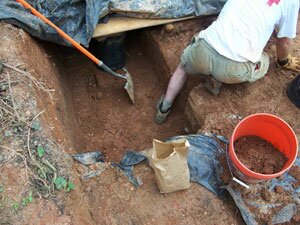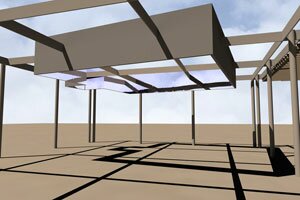Tiny modern nod: Shadowy plan honors slaves' history
In 2001, when UVA selected the architecture firm the Polshek Partnership to design the new South Lawn project, architects at the University had hopes the new creation would be a departure from the faux Jeffersonian architecture characterized by such things as the Darden School. After all, Polshek is known for modernist visions like the dazzling Clinton Library in Little Rock and the innovative façade of the Brooklyn Museum.
However, after three years of preliminary design work, UVA's Board of Visitors parted with Polshek in favor of a more traditional Jeffersonian design by the firm Moore Rubel Yudell. Polshek's disappointed lead architect on the project, Tim Hartung, noted after the decision, "We would like to think we were selected because there was a desire and a hope to do something different and more modern."
Some at the university agreed. Over 30 members of the architecture faculty published an open letter in the Cavalier Daily condemning the shift toward a more traditional Jeffersonian design, dismissively referring to it as "the project south of the Lawn" and characterizing it as "apologetic neo-Jeffersonian appliqué."
The letter also accused the BOV of allowing public relations and marketing to dictate the design and perpetuating architecture with "symbolic, synthetic veneers lacking any virtue beyond familiarity."
In June, UVA architecture professor and City Planning commissioner Bill Lucy made it clear how he felt about the project. "The bridge, or plaza over JPA, will have absolutely no function. It's just a phony image with no sense to it," he told the Hook.
However, despite such sharp criticism from university insiders, the South Lawn project proceeded full steam ahead, culminating in an elaborate ground-breaking ceremony on September 29 kicking off UVA's new $3 billion fund-raising campaign. It appeared the suits had won.
But wait! It looks like a different kind of ground-breaking that took place in 1993 is going to result in a departure from Jeffersonian design that the disgruntled architects had hoped for.
While expanding the parking lot behind new Cabell Hall in 1993, workers stumbled upon what they believed to be grave shafts. Sure enough, when UVA archeology students began excavating the site they found 12 grave shafts and artifacts including nails, ceramic dolls, marbles, buttons, and buckles.
Over the next three years, UVA funded an investigation on the site that revealed a startling discovery: 2.8 acres of land and the remnants of a building owned by Kitty Foster, the first freed black slave to own property in Charlottesville.
According to archeologist Ben Ford with the Rivanna Archaeological Services, Foster bought the property in 1833, well before emancipation. Ford suspects she was a seamstress or laundress, one of many workers who may have lived in the area to serve the needs of the University.
In 2005, Ford was brought in to explore the site as part of preliminary work for the South Lawn project, and made even more startling discoveries: 20 more grave shafts– including several that appeared to be family plots– and thousands of new artifacts.
"The cemetery is very significant," says Ford. "When we found the additional graves, we realized we'd found a community."
That community, says Ford, is believed to have been called Canada (named for the free country to the North that slaves dreamed of escaping to), which probably extended east to Oakhurst Circle south of JPA, west of Lee Street, and north of the nearby Norfolk Southern railroad line. Ford suspects that Canada developed in the 1860s as a rental neighborhood for free blacks and that after emancipation, especially in the 1870s and 1880s, there was a sharp turnover of properties in the area from white to black ownership.
"We feel the site is eligible for the National Historic Register," says Ford. "There were very few free black urban sites in Virginia, it's largely intact, and it's important to the history and development of the University."
Apparently, the University has taken note. As part of the South Lawn landscape design, the Kitty Foster site will be recognized with a sort of living sculpture and landscaping that reveals some of what archaeologists have found, including the cemetery and a portion of an elaborate five-foot wide cobblestone and brick pedestrian pathway.
Although it has received little attention in the press, the design of the Foster site is definitely a departure from the Jeffersonian grid work in the new South Lawn design. During a presentation of the project before the Charlottesville Planning Commission by UVA architect David Neuman last month, landscape designer Walter Hood's presentation of the abstract Foster site design had little in common with the traditional look of the larger project.
Think Picasso in a room full of Whistlers. Hood spoke of the "spirituality" of the haunting design, which involves the construction of a grid and a "shadow catcher" over the site that will allow the sun to cast sculptured shadows over the cemetery and assimilate the grid lines of the archeological dig. Aluminum reflectors will also be placed beneath the structure to reflect the sun. In addition, the ground above the cemetery will be shaped and mounded to represent the graves, and the plantings and trees on the site will follow none of the schemes planned for the South Lawn project.
"In trying to dignify the site, I created a sculpture that's trying to provoke contemplation of what lies beneath," says Hood. "Instead of marking the ground, I've marked the sky."
Hood hopes the structure will emphasize the duality between shadow and light, and create a space where people can access the unseen.
"Hopefully, the shadows and reflective elements in the scultpture will be a kind of 'flash of the spirit,'" says Hood, "to give people a ride to heaven."
"I thought it was shocking that so little has been mentioned about the archeological dig," says Ford, commenting on all the publicity surrounding the South Lawn project, especially considering the extensive work the University did investigating the site. "I think the Foster site project is a tasteful and unique design that breaks away from the traditionalism of the South Lawn Project," he adds.
Indeed, that seems to have been Hood's intention.
"Slaves created their own network of structures away from the University," he says. "I was interested in having this kind of departure where you realize you are somewhere else."
That may be little consolation to the UVA architects who had wanted the larger project to be a departure, but it seems fitting that a monument to an entire community that the University forgot might trump Jeffersonian design.

A 2005 archaeological dig uncovered 20 more grave shafts, bringing to total to 32.
FILE PHOTO BY MARY COCKERILLE

The "Shadow Catcher" will honor the Kitty Foster cemetery site with shade and sun.
PHOTO COURTESY WALTER HOOD